
- •Министерство образования и науки Российской Федерации
- •About myself and my study
- •Vocabulary:
- •Building materials
- •Vocabulary:
- •Shear wall and frame systems
- •Vocabulary:
- •Boulton house, cambridge, england
- •Vocabulary:
- •Assembly of elements at floor above ground level
- •Vertical section through typical upper floor
- •Saint petersburg
- •Vocabulary:
- •Urban design
- •Vocabulary:
- •Eco-architecture
- •Vocabulary:
- •Computer systems
- •Vocabulary:
- •The wide world web
- •Vocabulary:
- •Computer software and hardware
- •Vocabulary:
- •Internal combustion engine
- •Vocabulary:
- •Automobile safety
- •Vocabulary:
- •Hybrid cars
- •Vocabulary:
- •Vocabulary:
- •Excavators
- •Vocabulary:
- •Power installations of construction machinery
- •Vocabulary:
- •Price elasticity of demand and supply
- •Vocabulary:
- •Fiscal policy
- •Vocabulary:
- •Foreign trade
- •Vocabulary:
- •Heat exchangers
- •Vocabulary:
- •Boilers
- •Vocabulary:
- •Air conditioning
- •Vocabulary:
- •Оглавление
- •Английский язык
Vertical section through typical upper floor
haluminium window frame with opening light;
i precast concrete H-frame with 1'-8" deep spandrel beam and 6¼" x 11¼" columns.
А, РРАН, ДАС, Гр (II семестр)
Saint petersburg
18th Century
St Petersburg is one of the cities in the world built according to conceived scheme. In 1716 the French architect Jean-Baptiste Le Blond created the general layout for the construction of St Petersburg and after his death the work in accordance with this plan started under supervision of the Swiss architect DomenicoTrezzini.
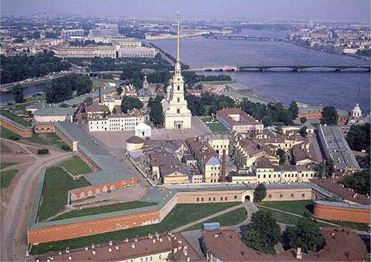 The
first structure of the future city was the Peter and Paul Fortress.
Peter the Great himself made a suggestion on the overall scheme of
the fortress. Trezzini designed the stone Peter and Paul Cathedral in
1712 on the site of a wooden church. Soon the entire fortress took
the cathedral’s name. The cathedral is the most important example
of the Petrine Baroque.
The
first structure of the future city was the Peter and Paul Fortress.
Peter the Great himself made a suggestion on the overall scheme of
the fortress. Trezzini designed the stone Peter and Paul Cathedral in
1712 on the site of a wooden church. Soon the entire fortress took
the cathedral’s name. The cathedral is the most important example
of the Petrine Baroque.
During the reign of Elizabeth, the daughter of Peter the First, Saint Petersburg changed its appearance beyond recognition and turned into a splendid city of luxurious palaces designed in the Baroque style. Francesco Rastrelli was the most outstanding architect of that time. His greatest creation was the Winter Palace.
T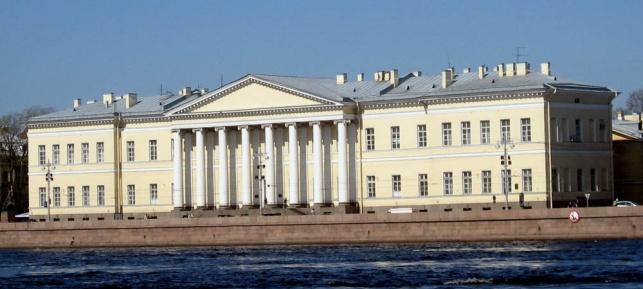 he
Baroque was displaced by Neo-Classicism during the reign of Catherine
the Great. Its typical examples are the Tauride Palace built by the
Russian architect Ivan Starov and the projects carried out by the
Italian Giacomo
Quarenghi
(Smolny Institute, Hermitage Theatre, the Academy of Science and
others).
he
Baroque was displaced by Neo-Classicism during the reign of Catherine
the Great. Its typical examples are the Tauride Palace built by the
Russian architect Ivan Starov and the projects carried out by the
Italian Giacomo
Quarenghi
(Smolny Institute, Hermitage Theatre, the Academy of Science and
others).
19th Century
T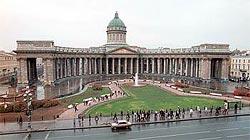 hat
century began with the construction of the Kazan Cathedral
(1801-1811) when the Empire style of Late Classicism was predominant.
The Russian architect Andrey
Voronikhin,
a former serf, made the Cathedral’s project.
hat
century began with the construction of the Kazan Cathedral
(1801-1811) when the Empire style of Late Classicism was predominant.
The Russian architect Andrey
Voronikhin,
a former serf, made the Cathedral’s project.
The most impressive landmark was the ensemble of three large squares – Palace square, St Isaac’s square and Senate square. The appearance of this part of the city reflects the traditions of urban construction formed in the eighteenth and early nineteenth centuries – the principles of “remarkable buildings”, “regular squares”, and “continuous linking of streets”. The focal element of the complex of the three squares is the Admiralty created by Andreyan Zakharov.
S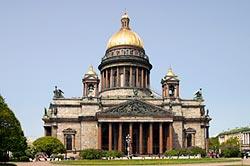 t
Isaac’s Cathedral was designed by the French architect Auguste de
Montferrand and consecrated to St Isaac of Dalmatia, whose name-day
coincides with the birthday of Peter the Great.
t
Isaac’s Cathedral was designed by the French architect Auguste de
Montferrand and consecrated to St Isaac of Dalmatia, whose name-day
coincides with the birthday of Peter the Great.
Drawbridges spanned the Neva, streets were paved with stone; at the end of the nineteenth century electric lamps illuminated the streets.
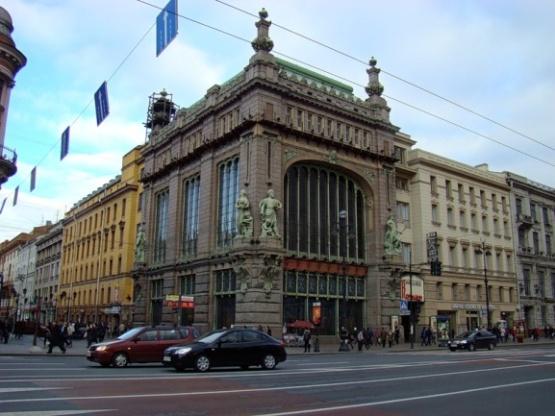
20th Century
By that time Art Nouveau broke into the city’s architectural silhouette. The Yeliseyev Brothers Trade House (1900-1903) was built in stone, concrete and glass. It has many impressive details: a huge glazed surface of the façade, a large stained glass window, heavy stone facing and naturalistic sculpture ornaments typical of the Art Nouveau style.
Towards the beginning of the 20th century Nevsky Prospect was occupied by business people, for whom huge buildings of banks, trade houses and company offices were built. One of such structures was put up for the American company (Singers & Co) known for many years as the House of Books (1902-1904).
2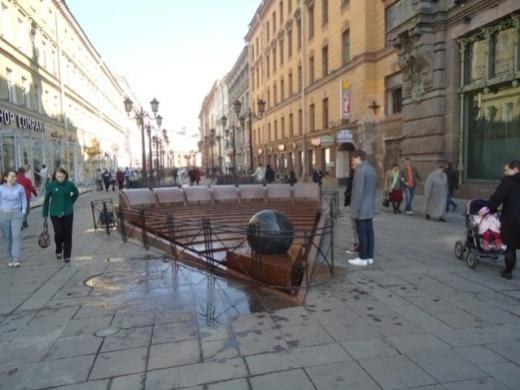 1stCentury
1stCentury
Present-day architects continue improving and decorating Nevsky Prospect. In recent years pedestrian friendly zones were created in Malaya Koniushennaya and Malaya Sadovaya Streets running from Nevsky Prospect. Malaya Sadovaya Street was paved with tiles, the street separation and sidewalk were removed, a fountain featuring a Kugel ball (a heavy stone ball easily rotatable because of lubrication by the fountain’s water) was built. Later new monuments and hardscape were installed there.
Saint Petersburg is often described as the most Westernized city of Russia, as well as its cultural capital. It is the northernmost city in the world having the population of over one million. Since around the end of the 20th century a great deal of active building and restoration works have been carried out in a number of the city's districts. The Historic Centre of Saint Petersburgand Related Groups of Monuments constitute a UNESCO World Heritage Site.
